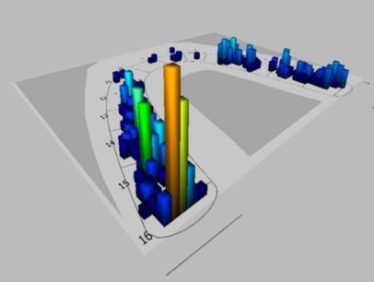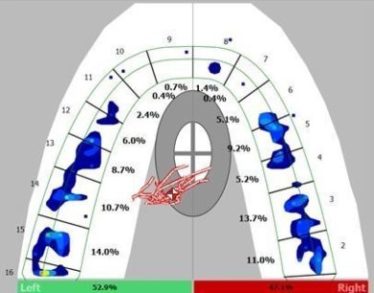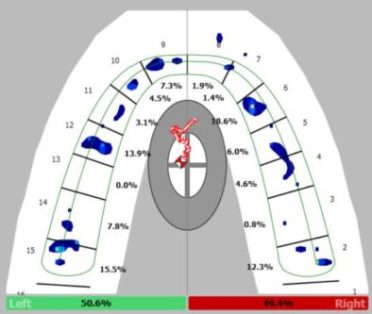Point-Line-Frame-Cycle-Pattern
Point-Line-Frame-Cycle-Pattern refer to force measurement recorded by T-Scan® force scans. In other words, force is quantified and qualified by intensity (points), direction (lines), sequence (frames) and repetition (patterns) of force distribution cycles.
The ‘point’ feature displays the intensity of each contact measured by a T-Scan® sensor. The graphic on the left shows a T-Scan® sensor and a single sensel.
Each sensel can detect up to 256 levels of intensity which appear as pixels in basic 2D format, as a blend in 2D contour, and as columns in 3D format.
A scan in 2D format (pictured above left) is easy to interpret because dentists are familiar with the location of articulating paper marks. Force distribution scans reveal the complete information behind ink marks and provide permanent records.
The ‘line’ feature shows the direction in which force travels on an occlusion. Two points of force create a line. The picture on the left illustrates how two points simultaneously touching across the arch create a long line. The picture on the right illustrates how two points close together create a short line.
A line provides diagnostic information. Intensity is distributed across a bite as more teeth touch during a force cycle. Lines between points tell us if the dominant force stays in one area, like in the example on the right, or if the force is quickly spread across the arch like in the example on the left. Lines show us the direction in which force is traveling from one point to another. Lines are helpful in measuring CR-CO slides, left or right lateral slides, protrusive/retrusive slides, and cross-bite slides.
The ‘frame’ feature displays simultaneous contacts at a single point in time. A sequence of frames allow us to visualize force distribution cycles. Each force distribution cycle mimics a critical part of the envelope of function. It starts when the first point of contact is registered and ends when all contacts have released. Frames are recorded in the “Real-Time Window” for display and analysis. When analyzing a single frame, it is important to note when it occurs within the force distribution cycle.
A ‘pattern’ is produced after several force distribution cycles are repeated over and over during the same recording. Patterns of force distribution are diagnostic as they correlate to a patient’s anatomy and postural habits.
Repeated use of force scans teaches how to recognize patterns. Every frame adds to the animated movie of repeating force distribution cycles. Articulating paper gives an idea of the location and position of force under maximum contact in one plane. However, the ink marks cannot illustrate points, lines, and sequence. It is the analysis of these points, lines, and frames that really show us the “bigger picture” of an occlusion.
Habitual Force Distribution Patterns vs. Skeletal Force Distribution Patterns
First, it is very important to note the difference between a pattern recorded when a patient is in pain versus when a patient can close normally, without restriction. Pain makes a patient’s habitual force pattern change. A good analogy is that of a sprained ankle which would alter a patient’s walking pattern while in pain. Second, it is important to understand the difference between habitual force distribution patterns (HFDPs) and skeletal force distribution patterns (SFDPs). Every patient has two bites, the habitual one in centric relation (CR) and the skeletal one in centric occlusion (CO). The difference between the two bites has a one-to-one relationship to dysfunction. The greater the difference, the greater the dysfunction.




